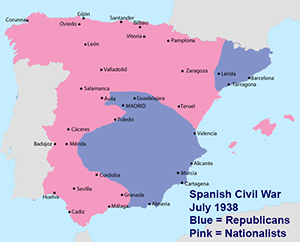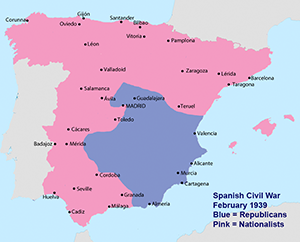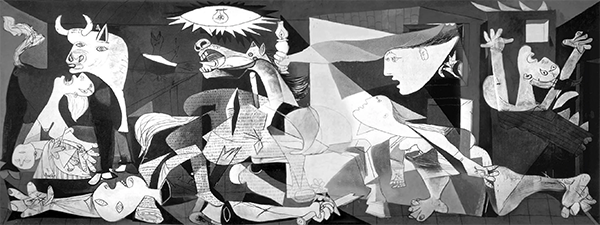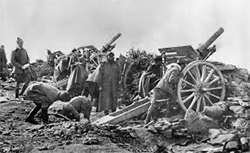The Spanish Civil War
Part 3: Devastation and Victory

Franco, firmly control of the military effort, also enjoyed solidarity of the coalition arrayed behind his effort to overthrow the government. Chaos, however, consumed the Republican efforts to defend themselves, as two main Communist factions faced off against each other in the midst of the war. Government forces sought to negotiate a cease-fire in May 1938, but Franco insisted on unconditional surrender and so on the fighting went. Dominating the second half of that year was the Battle of Ebro, an attempt by Republican forces to shore up their territory. It ended well, for Franco, who pushed on into Catalonia. 
When Franco's troops took Barcelona in January 1939, France and the U.K. agreed to recognize the general as the military leader of what would be a new government. The Nationalists' taking Madrid in March all but sealed the surrender that came the following month. Tens of thousands of refugees fled over the border into France. Franco took over the government and served as dictator until his death, 36 years later. The death toll, by highest counts, exceeded 1 million. Most sources have totals in the hundreds of thousands. Historians estimate that both sides together executed more than 200,000 prisoners of war. In addition to Orwell, who was shot in the neck while serving in a Republican unit, a large number of famous authors were in Spain at the time, including Ernest Hemingway, Langston Hughes, Pablo Neruda, and Dorothy Parker. Antoine de Saint-Exupéry reported various elements of the war by flying a plane overhead. Capturing the devastation in a stark way was the Spanish painter Pablo Picasso, whose Guernica (below) chronicled the devastation wrought by German troops on the defenseless town of the same name.  First page > Conflicts Arising > Page 1, 2, 3 |
|
Social Studies for Kids
copyright 2002–2025
David White



 A Nationalist air raid in April 1937 left the city of Guernica in ruins. Nationalist forces claimed Bilbao two months later. By October, Nationalists controlled much of the western half of the country but had yet to take Madrid or other key cities under Republican control elsewhere. However, the presence of a large number of professional soldiers on the side of the Nationalists began to make a difference. Republican armies had trained soldiers, too, but they also had a large number of volunteers.
A Nationalist air raid in April 1937 left the city of Guernica in ruins. Nationalist forces claimed Bilbao two months later. By October, Nationalists controlled much of the western half of the country but had yet to take Madrid or other key cities under Republican control elsewhere. However, the presence of a large number of professional soldiers on the side of the Nationalists began to make a difference. Republican armies had trained soldiers, too, but they also had a large number of volunteers.
